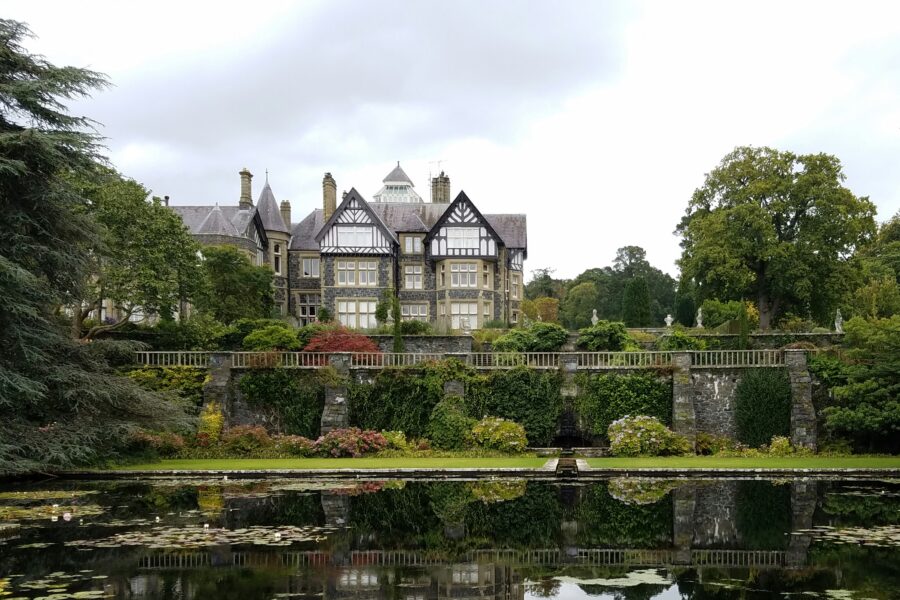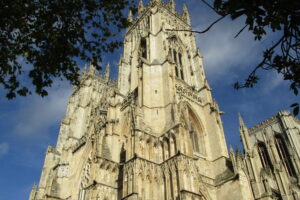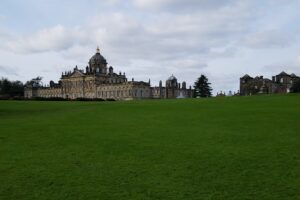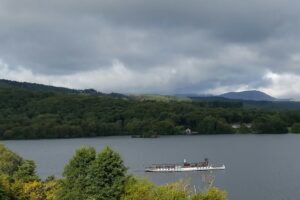Once we get out of the maze of bridges and freeway-turns through Conwy, the drive to Bodnant Gardens seems pretty simple. Drive straight, veer left. Stumbling on their listing last night, I am not sure exactly what type of gardens we are about to visit. Reaching the parking lot doesn’t tell me a lot more, other than the parking lot is really big and climbs both sides of a hill. At 10:00 a.m. the lower level car parks are full, causing us to travel further, higher, to find space.
Following the descending trail, looking for a sign to the entrance, we watch as a couple carting plants walk toward us. Did I really lead us to a garden center, not a garden? I worry and wonder. We keep walking, passing through a retail plant area on our way to the information center. While Michael pays I go in search of the WC.

He has the map so I follow his lead, still not knowing what to expect—except rain. My umbrella, like the weather, is in a constant state of change—opening when the sky does, closing when the rain stops. Walking down a path in the formal gardens I ask Michael to stop, evergreen trees I cannot name are so tall I want to take a picture showing the scale. He doesn’t stop as soon as I would like, but still, I’m able to capture the perspective.



Finally, my umbrella remains closed, swinging happily, looped around my left wrist. We walk up down around and through—stone steps, wooden bridges, gravel paths, damp dirt trails. Stopping at one of the many benches that are dotted throughout the gardens I study the map.
Looking at Michael, I break the bad news. “I think I understand why the English use the word massive. This place is massive—there is no other word to describe it! We need a week to really see everything—two days at least. Maybe we shouldn’t do the castle today.”





Michael agrees. We resume our walk at a much more relaxed pace, stopping frequently to smell the proverbial roses. Although there were hundreds of vehicles in the car park when we arrived, the paths we follow are virtually empty. When we do see other garden admirers we notice that they hardly ever stop and seem to never take photos; I think that we must stand out as gawking, overwhelmed, overawed, camera-toting Texans.

150 year old Giant Sequoia

After a long climb, at the crest of a hill, we stop to rest. I look beyond the stream, across the steep valley to the trunks of a stand of trees which seem to be iridescent. Michael tells me I’m not seeing things, they look iridescent to him too. This is the second time today plants look like they glow. I try to capture the scene but my camera does not tell the tale. I guess this is why you should paint from nature. Too bad I’m too lazy and not a toter of paints and brushes and easels—and smaller canvases.





The interior of the “Poem” family mausoleum. Only open to the public one day a week, I couldn’t see through the grill, but my camera could.
I bypass a cluster of hydrangeas, then drop my opened—once again—umbrella in the middle of the path to backtrack and take pictures. Hearing approaching walkers, I hurry back to the path retrieving the umbrella, apologizing to the couple whose way I blocked. Continuing along the path together, we talk about lost umbrellas and photos and when we catch-up with Michael the conversation explores other subjects. The last thing they tell us is that friends of theirs just flew to the states in order to follow Route 66 from beginning to end in honor of their 66th birthday. I don’t know why, but I’m shocked that people from the UK have heard of Route 66—especially as a tourist destination.


After hours of trekking up hills and down dales—and only seeing barely a third of the gardens—the Eggs Benedict we had for breakfast begin to wear off, our feet begin to wear out, and we see that there are only two hours left before our dinner reservation. We turn our feet toward the car park.

A bit more about Bodnant Gardens
The garden’s founder, Henry Davis Pochin, was a Leicestershire-born Victorian industrial chemist who acquired fame and fortune inventing a process for clarifying rosin used in soap, turning it from the traditional brown to white. He became a successful businessman, mayor, and JP.
Pochin bought the Bodnant estate in 1874 and employed a professional to redesign the land around the existing Georgian mansion house, that were only lawns and pasture at the time. Together they relandscaped the hillside and valley, planting American and Asian conifers on the banks of the River Hiraethlyn, and reinforcing stream banks to create a woodland and water garden in the valley. In the upper garden, they created the Laburnum Arch and glasshouses, to house exotics. Pochin also built The Poem, the family mausoleum in an area of the Shrub Borders.
From 1905–1914 Pochin’s grandson, Henry McLaren, oversaw the completion of the five terraces. This was a massive earth-moving project done by men without machinery, which involved leveling the hillside and building granite buttress walls which provided protection for tender plants being introduced to the garden from overseas. The Pin Mill building on the Canal Terrace was added in 1938. Originally built in 1730 in Gloucestershire, it was rescued from decay by Henry, who dismantled it, brought to Bodnant and rebuilt it brick by brick. He oversaw the major developments of the garden, sponsoring plant hunting expeditions of the day by explorers who brought back plants from China and the Himalayas including magnolias, camellias and rhododendrons. He also invested in a plant breeding program producing Bodnant hybrid rhododendrons.
Henry went on to become president of the Royal Horticultural Society for 22 years. He persuaded the National Trust to accept gardens on their own merit and in 1949 he handed over Bodnant Garden to the National Trust.
Route 66 Holidays
See iconic America at its finest with a Route 66 holiday from Bon Voyage. Because who can resist this classic 2,448 mile journey through eight states and three time zones?
…If you’re considering a Route 66 holiday, you may find one of our limited edition free Route 66 maps handy, don’t delay, contact us today ! We’ll also sign you up to receive ideas and inspiration about the USA.


















Leave a Reply
Your email is safe with us.